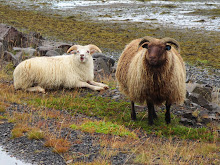The Sea Lions of Puerto Madryn
First there was the Donkey of Nazareth who ate my shirt. Now the shame of having my butt bitten by a sea lion.
This morning, far too early, C and I and two handsome, ripped fellows from Belgium were dressed up in full wet-suits (vests, socks, another body suit followed by more boots) then directed to walk over the beach and through the surf to a small boat moored out in the ocean.
Thus started our adventure to snorkel with Sea Lions.
Before setting out on this trip, I had to have assurance from our trusted guide Pedro who is a bit of a nut about eco stuff (in Parque Valdes he would stop and shoo off any errant tourists who had gotten out of their car in the unauthorized area as he did to me on the path at Tombo to take a penguino photo) that this DID NOT impact on Sea Lion behaviour or colony life.
The sea lions live in huge colonies along the coast of this area of Patagonia. The population consists mostly of female sea lions, juveniles and then the pups.
There is one large Bull Male and an assorted group of what are called Beta Males, who appear, as in the old Batman show from the 60s, to act as the henchmen of the Bull Male. The young or weak little males are banished to what are called "bachelor colonies". Mind you, maybe they're all the gay males and their part of the shore is the Fire Island of sea lion world.
At the sight of the dive we are given wet suit hoods for our heads as well as three finger neoprene gloves. The Belgiums make jokes about us looking like the knights from "Monty Python's Holy Grail". That's actually pretty accurate.
Then on come our flippers, masks, snorkels and then ordered off the boat and into the water.
Sea Lions came as soon as we anchored, a few at a time, playful and jumping around us.
What would happen soon was a strange parly between two tribes of extremely curious mammals.
We have us in our weird masks and suits and suddenly sea lions from left to right come out to see what's up.
They check us out from a few feet at first, diving up and around us usually below looking directly into your eyes from beneath you.
The fundamental link between me, a human, and the wild sea lion, cements in that moment: They are as fascinated by, and wary of us, as we are of them.
I try and play it cool and only make eye contact with them and say 'hello' through my snorkel as they swim around me.
Then soon, more come and more and more.
If you were a Newfoundlander you would say the "sea was maggoty with seals".
It starts with one older matriarch seal. I can tell she likes me. She swims right against me and rubs her wiskers against my hand. I start to pet the side of her neck and her eyes close half shut like a cat and she stays with me for minutes purring at my stroking of her fur. She swims away to tell the younger sea lions that I am okay.
The sea lions also like my friends from Belgium. Suddenly after the matriarchs have given an "okay" all these sea lions just start surrounding us. Swimming in bewteen over and right beside us. They like it when you to surface with them, look at their eyes and then dive down again with them.
In a scrum of sea lions, one swims beneath me and throws me up a few feet out of the ocean and into the air.
Spinning, turning, diving, swimming up and down the sea lions surround us in clear, aquamarine waters looking directly into our eyes. They want us to stroke their wiskers, swim down with them and, as a puppy does, they continue to invite play.
***************
We humans spend all this time pondering whether God exists. We want some determination that an intelligence, other than ours, exists.
Astronomers search for evidence of life beyond earth: Are these remains of fossilized bacteria in a stone from Mars? Is there rudimentary bacteria or protein chains in guck ponds on near moons?
Are there UFOs? Watchers?
Yet here on on blue, watery and delicate Earth, live all sorts of extreme, strange but related creatures: cousins many times removed who are as interested in us, as we are in them.

